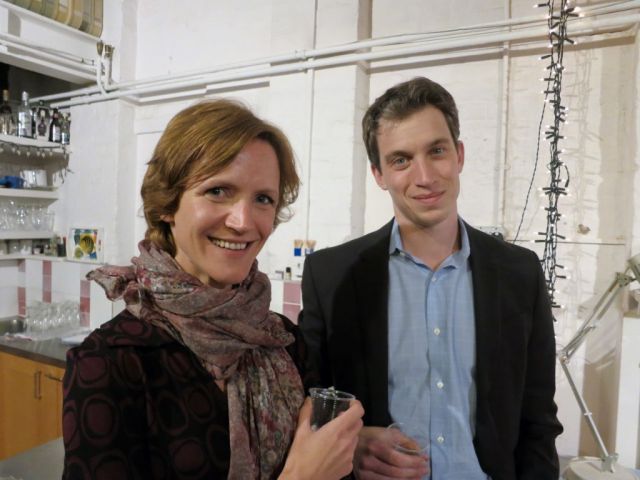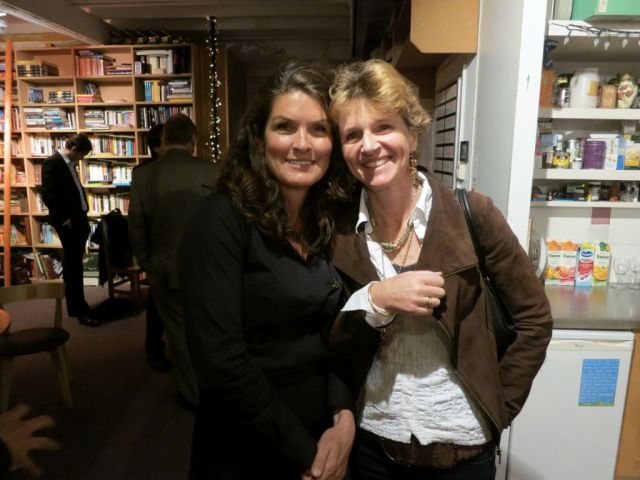Introduction by John Brockman
"I thoroughly enjoyed the evening last week," emailed Brian Eno. "A lot of interesting people got connected together and everyone told me they enjoyed themselves."
He was referring the first-ever London Edge Reality Club meeting, featuring a presentation by Cambridge research psychologist Simon-Baron Cohen which Eno hosted at his studio in Notting Hill before an assembled group that included artists, curators, museum directors, writers, playwrights, scientists in fields such as biology, math, psychology, zoology, the editors and correspondents of Nature, The Economist, Wired, The Guardian.
Baron-Cohen held forth before this diverse group on his latest research on the properties and effects of the hormone testosterone, while showing its relevance to his earlier research in sex differences and autism.
The variety of people at the meeting reflected the singular place in the London cultural scene occupied by our host, an artist, "non-musician", composer, columnist, record producer (U2, Cold Play, Talking Heads, Paul Simon).

Eno, Edge, Bono, Pavarotti - Miss Sarajevo | One HD
—JB

Click on "Slide Show" Link at Top for Photo Album
Simon Baron-Cohen, Research Psychologist, Cambridge; Max Brockman, Brockman, Inc.; Stanley Buchthal, Producer (Hairspray); Philip Campbell, Editor, Nature; Geoffrey Carr, Science Editor, Economist; Marcus du Sautoy, Mathematician, Oxford; Brian Eno, Musician, Artist; Mary Evers, Osteopath; Ed Hall, Cambridge, Student; Melanie Hall, QC (Queen's Counsellor); Maja Hoffmann, Kunstalle Zurich Foundation; Bruce Hood, Cognitive Psychologist, Bristol; Alok Jha, Science Correspondent, Guardian; Koo Jeong-A, Artist; John Lloyd, Comedy Writer, TV Producer; Katinka Matson, Co-founder, Edge; William McEwan, Cambridge; Hans Ulrich Obrist , Co-Director, Serpentine Gallery; David Rowan, Editor, Wired.UK; Simone Schnall, Social Psychologist, Cambridge; Tom Standage, Digital Editor, Economist; Tom Stoppard, Playwright; Seirian Sumner, Zoologist Institute of Zoology; Richard Wentworth, Artist, Curator; Russell Weinberger, Edge; Rosie Williams, Biologist, Cambridge; Hilary Wynter, Banker
TESTOSTERONE ON MY MIND AND IN MY BRAIN
[SIMON BARON-COHEN:] What I want to talk about tonight is this very specific hormone, testosterone. Our lab has been doing a lot of research to understand what this hormone does and, in particular, to test whether it plays any role in how the mind and the brain develops.
Before I get to that point, I'll say a few words by way of background about typical sex differences, because that's the cradle out of which this new research comes. Many of you know that the topic of sex differences in psychology is fraught with controversy. It's an area where people, for many decades, didn't really want to enter because of the risks of political incorrectness, and of being misunderstood.
Perhaps of all of the areas in psychology where people do research, the field of sex differences was kind of off limits. It was taboo, and that was partly because people believed that anyone who tried to do research into whether boys and girls, on average, differ, must have some sexist agenda. And so for that reason a lot of scientists just wouldn't even touch it.
By 2003, I was beginning to sense that that political climate was changing, that it was a time when people could ask the question — do boys and girls differ? Do men and women differ? — without fear of being accused of some kind of sexist agenda, but in a more open-minded way.
First of all, I started off looking at neuroanatomy, to look at what the neuroscience is telling us about the male and female brain. If you just take groups of girls and groups of boys and, for example, put them into MRI scanners to look at the brain, you do see differences on average. Take the idea that the sexes are identical from the neck upwards, even if they are very clearly different from the neck downwards: the neuroscience is telling us that that is just a myth, that there are differences, even in terms of brain volume and the number of connections between nerve cells in the brain at the structure of the brain, on average, between males and females.
I say this carefully because it's still a field which is prone to misunderstanding and misinterpretation, but just giving you some of the examples of findings that have come out of the neuroscience of sex differences, you find that the male brain, on average, is about eight percent larger than the female brain. We're talking about a volumetric difference. It doesn't necessarily mean anything, but that's just a finding that's consistently found. You find that difference from the earliest point you can put babies into the scanner, so some of the studies are at two weeks old in terms of infants.
You also find that if you look at postmortem tissue, looking at the human brain in terms of postmortem tissue, that the male brain has more connections, more synapses between nerve cells. It's about a 30 percent difference on average between males and females. These differences are there.
The second big difference between males and females is about how much gray matter and white matter we see in the brain: that males have more gray matter and more white matter on average than the female brain does. White matter, just to be succinct, is mostly about connections between different parts of the brain. The gray matter is more about the cell bodies in the brain. But those differences exist. Then when you probe a bit further, you find that there are differences between the male and female brain in different lobes, the frontal lobe, the temporal lobe, in terms of how much gray and white matter there is.
You can also dissect the brain to look at specific regions. Some of you will have had heard of regions like the amygdala, which people think of as a sort of emotion center, that tends to be larger in the male brain than the female brain, again, on average. There's another region that shows the opposite pattern, larger in females than males: the planum temporale, an area involved in language. These structural differences exist, and I started by looking at these differences in terms of neuroanatomy, just because I thought, at least those are differences that are rooted in biology, and there might be less scope for disagreement about basic differences.
I've talked a little bit about neuroanatomy, but in terms of psychology, there are also sex differences that are reported. On average, females are developing empathy at a faster rate than males. I keep using that word 'on average' because none of these findings apply to all females or all males. You simply see differences emerge when you compare groups of males and females. Empathy seems to be developing faster in girls and in contrast, in boys there seems to be a stronger drive to systemize. I use that word ‘systemizing’, which is all about trying to figure out how systems work, becoming fascinated with systems. And systems could take a variety of different forms. It could be a mechanical system, like a computer; it could be a natural system, like the weather; it could be an abstract system, like mathematics; but boys seem to have a stronger interest in systematic information. I was contrasting these two very different psychological processes, empathy and systemizing. And that's about as far as I went, and that was now some 11 years ago.
Since then my lab has wanted to try to understand where these sex differences come from, and now I'm fast-forwarding to tell you about the work that we're doing on testosterone. I'm very interested in this molecule, partly because males produce more of it than females, and partly because there's a long tradition of animal research which shows that this hormone may masculinize the brain, but there's very little work on this hormone in humans.
Before I tell you about the testosterone work, I should just mention one somewhat controversial study that we published back in the year 2000, and that was a study of newborn babies. What we wanted to do was establish whether the sex differences that you find in behavior, or in the mind, in human beings, were purely the result of culture and purely the result of postnatal experience, or whether biology might also be contributing to those differences.
We did a study that we call the Newborn Baby Study, where we studied just over 100 babies aged 24 hours old. This was a study conducted in Cambridge. The babies had just popped out of the womb. The mothers had signed a consent form saying that they were happy for their baby to take part in research. We would have loved to study the babies as soon as they came out, but the obstetricians asked us, out of respect for mother and baby, if we would wait 24 hours, which we were happy to do; and then when the babies were settled and the mother was settled, we presented these babies with two objects: a human face or a mechanical mobile suspended above the crib. So, two very different kinds of objects, one mechanical and one animate and human. And we looked to see whether babies, aged one day old, looked longer at the human face, a social stimulus, or looked longer at the mechanical object.
The objects were presented one at a time, and we counterbalanced, that's to say we varied the order, whether the baby saw the face first or the mechanical object first. What we found, just cutting to the chase, was that if we compared babies in terms of looking longer at a social stimulus or looking longer at a mechanical stimulus, more boys seemed to look longer at the mechanical stimulus, and more girls seemed to look longer at the social stimulus, the face. We were finding a difference that was there as early as 24 hours old; and that, to me, was pointing to biology being a contributing factor to sex differences.
People who really want to argue that all sex differences that you find in the mind and in behavior can be explained by cultural factors might still have argued that in those 24 hours, that mother and baby or father and baby had been interacting, that parents may have been somehow shaping their sons and daughters to have different patterns of interest. That is just possible, because in 24 hours, people would argue, there's plenty of room for experience. But it's equally plausible that what we're seeing is babies arriving on day one with slightly different patterns of interest: with girls on average, being more oriented towards people, being more inquisitive about people, and boys, again on average, being slightly more oriented in their attention towards the physical environment, and patterns in the physical world.
Now we're up to testosterone. We picked testosterone, this molecule, just because we were looking for a candidate biological explanation or mechanism for these sex differences we were observing. And the animal research was pointing to the fact that before birth there's a surge in the production of testosterone. Testosterone is suddenly produced at very high quantities and then it drops off again around birth. And the animal researchers were arguing that this surge in the production of testosterone, that the fetus is producing a lot of testosterone during fetal life, because it has some permanent and organizing effect on brain development. And they were able to show that in rats.
You can do experimental manipulations of this hormone in rats, that would be completely unethical in humans: you can either deprive the animal of its testosterone, for example, by castration at birth (since testosterone, one source of it in males is the testes); or you can inject extra testosterone, for example, into a female rat at birth, and look at the effects of brain and behavior. And that experimental evidence was pointing to long-term “organizational” effects on brain development.
Just to take an example, if you have a female rat that's given extra testosterone either during pregnancy or at birth, and then look at that female rat's behavior post-natally, her behavior is much more like a typical male rat. Ways that you can test this include, for example, letting the rats run through mazes, finding their way through a maze. If you take male and female rats, usually the male rats will get through the maze faster, learning a spatial route more quickly; but female rats that have been given extra testosterone are much more like typical male rats, so their behavior has been changed. And then if you look at post-mortem, at the rat brain, the female rats that were given extra testosterone, in terms of their neuroanatomy, the female rat's brain looks much more like a typical male rat's brain.
There was a hypothesis from animal research that testosterone was this special molecule that masculinizes the brain, and it was looking clearer and clearer in other species, but no one had found a way to demonstrate it in humans. What we've been doing over the last decade is to try to find a way to test it in humans. And the way that we settled on was to look at women in pregnancy who were having a procedure called amniocentesis. Many of you will have heard of this: this is where a pregnant woman has along needle introduced into the womb, the baby is in the womb surrounded by amniotic fluid, and the needle goes in as part of a medical, clinical procedure, to take some of that fluid. That's called amniocentesis, where you take some of the amniotic fluid that surrounds the baby. Usually this is done because there's some suspicion that the baby might have Down's syndrome, and the doctor wants to analyze the amniotic fluid for chromosomal abnormalities, as a test of whether the baby will indeed go on to have Down's syndrome.
These women were having this procedure, and the research had been telling us that if you wanted to look at hormones like testosterone, in terms of their potential influence on the human brain, you'd need to find a way of measuring it during pregnancy. We put these two things together and asked these women, if you're having an amniocentesis anyway, can we take some of the fluid, with your consent, and analyze it for testosterone levels that you find in the fluid? This is when the baby is sometime between 12 and 19 weeks of pregnancy. It's a little window when amniocentesis takes place. If you think of pregnancy as 40 weeks, normally, nine months, roughly 40 weeks, this is at the end of the first trimester, the first third of pregnancy, and just going into the second trimester, the middle of pregnancy.
We were getting this opportunity to measure hormones, but particularly testosterone, whilst the baby was still growing, at a point when the brain is developing very rapidly. And then the design of our research was that we would then store the fluid in our deep freeze, wait for the baby to be born, and follow up the babies after they were born to see if there was any correlation between their testosterone levels in the womb and how they turned out as children.
I should say one other thing, which is that this was premised on the idea that children are more different to each other than they are similar. Those of you who are parents know this very well: that you might have two or three kids and despite the fact that they've grown up in the same home, they've got the same parents, they seem to have very different personalities, very different patterns of interest, and very different rates of development. Part of the challenge, scientifically, was also to try to understand this variability in development, individual differences in development, and we were anchoring our research by looking at one factor, testosterone, which varies, with some people being very low in testosterone, other people being average or very high in testosterone, and seeing whether that scale of individual differences had anything to do with individual differences we see post-natally: for example, in rates of language development, in how sociable children are, and on other dimensions.
The study was that the woman had her amniocentesis while she was pregnant, we then waited for the baby to be born, and we've invited these babies in pretty much every year since their birth. We started off with about 500 of these babies, that's the cohort, where their testosterone levels are known, and we've been following them and they're now about 12 years old. So it's a story that's been unfolding whilst we've been able to measure the behavior as they grow, and see whether it has anything to do with their testosterone prenatally.
At their first birthday, we looked at eye contact. And I was particularly interested in this, because my main area of research is autism, and children with autism make very little eye contact. Their eye contact is at the extreme, showing very little interest in faces. But we'd already heard from that newborn baby study that there seems to be, on average, a sex difference in how interested people are in faces, and making eye contact, with girls being, on average, more interested in faces than boys, but there's a whole spectrum of individual differences. And what we found was that the higher the baby's prenatal testosterone, the less eye contact they made at their first birthday. That was simply measured by inviting the toddler into our lab, videotaping them and then later coding those videotapes for how many times the baby looked up at their mother's face. That was at the first birthday.
At the second birthday we looked at language development. We got parents to fill in a checklist of how many words does your child know, and how many words can your child produce. We were looking at the size of children's vocabularies. What we found, which was quite striking to us, was that by two years old, there were some children who had very small vocabularies, only about ten or 20 words, they were kind of at the low edge of normal development; and there were some kids who were really chatty and had 600 words. So the size of the differences in vocabulary was immense. And then we could look back at their testosterone levels.And once again, we found a significant correlation: that the higher the child's prenatal testosterone, the smaller their vocabulary at two years old. So this same hormone seemed to be related not only to patterns of social interest, whether you look at faces, but also to communication, how talkative you are and your rate of language development.
I don't want to go through all the steps, but we've also looked, when they were four years old, at empathy, finding that prenatal testosterone is negatively correlated with empathy. So again, it's the same pattern we were just hearing about: that if you were higher in testosterone during the pregnancy, it meant that you were slower to develop empathy as a four year old. And again, there are different ways that you can measure that. You can ask parents to fill in questionnaires about their child's empathy. You can actually get the child to take various empathy tests, or you can also get information about how easily the child mixes in school with other children. But the hormone, once again, was showing relationships with social behavior at school age.
We were also interested in that concept of systemizing, how strong a child's interest was in systems of different kinds. Was this a child who liked to collect things, to have the complete set, for example, that makes up a system? Was this a child who loved to take things apart and put them back together again? So, very much interested in construction and assembly and figuring out how things work? Was this a child who spotted the small differences between different makes of cars, or little toy cars, and could tell you the differences between different varieties of system? Again, what we found, but this time the correlation was flipped over, was a positive correlation with prenatal testosterone. The higher the child's prenatal testosterone the more interested they were in systems of one kind or another.
When they were about eight years old, we figured it was time to invite these kids into the MRI scanner, so that we could look directly at the question of whether testosterone is actually changing the way the brain is developing. Up until now we'd only done what's called behavioral studies, where we could find relationships between testosterone and behavior. But by eight years old a child is old enough to stay still, which is essential in a brain scan, because if the child squirms and moves around too much, then you can't interpret the results. These children, by eight, were able to tolerate having an MRI scan and we were able to look at the structure of the brain and see if it had any relationship to prenatal testosterone. And in fact, there are lots of interesting relationships.
As I mentioned, one region of the brain that differs between males and females is that region called the planum temporale, a language area, and that's related to prenatal testosterone. The hormone is having an effect on the way the brain is growing, just looking at the volume of different regions in the brain. We looked at one other region, which is the corpus callosum. Some of you will have heard of this: it's the connective tissue between the two hemispheres, and the hormone was correlated with the asymmetry of one part of the corpus callosum, just towards the back of that structure. This was the first evidence that the hormone in humans is having an effect on brain structure, brain development, and it was mirroring what the scientists who do animal research had been telling us all along, but we needed to demonstrate it in humans.
I want to bring this back to my interest in autism: autism is a neurological disability, and it affects boys much more than girls, and we were interested in the possibility that that same hormone, prenatal testosterone, might be a risk factor, or might be playing some role in the outcome of autism. I told you that the sample of children we were studying was about 500 kids. And autism is a relatively rare condition. It affects about one percent of the population. What that means is within 500 kids, there might be five children who have autism, which would be way too small a number to be able to draw any inferences about prenatal testosterone and association with this medical diagnosis.
We've been tackling the problem in two different ways. The first way is that within these 500 children we've used a dimensional measure of autism, rather than looking at whether the child has autism or not. We've been looking at the dimension of autistic traits, where you can look at the number of autistic traits a child has. The assumption is that we all have some autistic traits and that autism isn't categorically different to the rest of the population. It's simply at an extreme of a bell curve, a normal distribution of autistic traits. There are ways to measure autistic traits. Most of them are questionnaires. You get the parents to fill out a questionnaire, which is basically a way of describing how many autistic traits their child has, and then independently, you can look at their prenatal testosterone and see if there's any correlation.
What we found, maybe some of you have anticipated the result of this particular stage of the research, is that the higher the child's prenatal testosterone, the more autistic traits they were showing at different stages in development, at two years old, and we've repeated that at four years old. That's telling us about prenatal testosterone and autistic traits. But what we'd really like to do, and this is bringing you right up to date with where our research is, is to see whether there's any relationship between prenatal testosterone and actually developing autism.
As I've already explained, having a sample of 500 kids doesn't allow us to answer that question, so we've been collaborating with scientists in Denmark, in Copenhagen, at the Biobank there, because in Denmark they've been collecting amniotic fluid from women who have amniocentesis in Denmark. But they've been collecting those samples since 1980, so they have 100,000 samples sitting in their deep freeze. And for a scientist, that's a wonderful opportunity. The other thing that Denmark has is a national register for psychiatric diagnosis. Every time anyone in Denmark develops any kind of psychiatric condition, they're put into a central database, and so we know across the whole of Denmark, who has autism. We can go to the Biobank and fish out their amniotic fluid if it's in there, to analyze it for prenatal testosterone.
Whereas in our normative study of 500 children, we were dependent on doing the first measure of the hormones in pregnancy and then waiting for life to unfold over a ten-year period, in this new study, we can work backwards. We can say we know who's got autism, and we can look to see whether their amniotic fluid is still in the deep freeze. That then gives us, if you like, a fossil record of what their hormones were like, what their levels of testosterone were like when they were in the womb. It's reverse engineering the problem. And to just tell you where we're up to, we've just completed that study. The analysis is going on as we speak, so we hope to publish the results of that study later this year. Effectively, that will tell us whether testosterone levels are elevated prenatally in children who go onto receive a diagnosis of autism. And we're relatively confident that those results will be available during 2012.
This is a hormone that has fascinated me. It's a small molecule that seems to be doing remarkable things. The variation we see in this hormone comes from a number of different sources. One of those sources is genes. Many different genes can influence how much testosterone each of us produces, and I just wanted to share with you my fascination with this hormone, because it's helping us take the science of sex differences one step further, to try to understand not whether there are sex differences, but what are the roots of those sex differences? Where are they springing from? And along the way we’re also hoping that this is going to teach us something about those neurodevelopmental conditions like autism, like delayed language development, which seem to disproportionately affect boys more than girls, and potentially have us understand the causes of those conditions.
Q & A
TOM STANDAGE: What's the thing that determines the level of the testosterone in the womb? What's the next step along the path?
BARON-COHEN: I mentioned that there are at least 25 different genes that can influence how much testosterone any of us produces. If we had been in that study, if we were part of that cohort, it's our genetic makeup in part that influences how much testosterone each of us produces. And these are genes that are common genes, they're not rare mutations, they're common genes we all have, but it just depends on which version of the gene you have. They're polymorphic genes, different versions of the same gene. So that's one possible source of variation in testosterone levels, but there may be other sources too.
GEOFFREY CARR: How much of the variance between the sexes is captured by the variants in the testosterone levels? Obviously a male fetus is going to have more than a female. Is that a complete explanation of the difference?
BARON-COHEN: I'm very glad you've asked that. You're asking: is testosterone the only factor of interest? The answer is definitely not. It's one factor of interest. It may be accounting for about 30 or 40 percent of the variance, so it's not the only player in producing these differences. We could imagine that another set of very important influences would be genes on the X chromosome, so X-linked genes, just because we know that females have two X chromosomes, and us poor males only have one, and that may well make a big difference. So that would be a separate non-hormonal set of influences which …
GEOFFREY CARR: We all have X chromosome genes …
BARON-COHEN: We do, but there are various mechanisms which mean that if you have two copies of the X chromosome, the genes may work differently. One of them, for example, is called imprinting, which is a well known mechanism where if you've got, for example, two X chromosomes, as females in this room are assumed to have, genes on one X chromosome can affect the homologous gene on the other X chromosome. That's an imprinting process, and that could change expression levels of proteins, for example. That would just be one example of a non-hormonal, non-testosterone related influence on brain development and behavior in humans.
PHILIP CAMPBELL: Are the animal models telling us about what the testosterone is actually doing, that's in the brain development?
BARON-COHEN: Yes. I didn't mention that but I'm really glad you've raised it. Testosterone by itself doesn't really do anything, but for testosterone to do its work it has to bind to androgen receptors. There are these receptors that are just waiting for testosterone and when testosterone is bound to the receptors, then it can start influencing all sorts of other processes. Androgen receptors are all over the body, but they're also in the brain and in some of those regions like the amygdala or the planum temporale. These regions are sexually dimorphic: they're different in one sex or another, and they're very rich in these androgen receptors. We know that from animal work, and people are beginning to create maps of androgen receptors across the brain. It's all about the hormone binding to these receptors.
Once it's bound, the hormone can do all sorts of things. It can, for example, modulate neurotransmitters. There's one called serotonin. There's another one called GABA. And testosterone seems to modulate how those neurotransmitters work, so chemicals that affect the way neurons fire. Testosterone also seems to affect connections that neurons make with each other. There's a process called apoptosis which some of you will have heard of, which is selective cell death, where neurons, or nerve cells in the brain, are pruned, so that we lose certain connections. Testosterone seems to affect the rate at which we lose those connections.
STANLEY BUCHTHAL: Are various regions factored in, because in the United States autism is rising rapidly?
BARON-COHEN: Autism is rising rapidly all over the globe. It's not just the U.S. It's happening here, too. When I started out in the field of autism research, about 25 years ago, the reported rates of autism was four in 10,000 children. And everyone agreed that that was the rate of autism, about 1 in 2,500 kids. Whereas the reported rates of autism today are about one percent. It's gone from being very rare to being relatively common. Everyone's wondering what those increases in prevalence are due to.
Is it due to something in the environment? That would be one possibility. Or is it just due to better recognition and the fact that we are now trained to look for it, so we've got better diagnosis? My own view is it's probably explained by the latter: that there's been raised awareness of autism, and also there are more services on the ground for autism. There are clinics in almost every small town that can diagnose a child with autism, whereas 25 years ago there were probably only two or three centers in the country that were expert in diagnosing autism in this country. Just those ordinary factors, of more services, more awareness, and also some changes in how we classify autism. We've broadened the category so that we don't just pick up the severe forms of autism, but also milder forms. Those are the sorts of factors that I think, by themselves, could explain why we've gone from a relatively rare condition to a relatively common condition.
The reason I’m emphasizing these kind of mundane explanations for the increase in autism, is that I’m sure we’re all aware of the MMR theory, the measles, mumps and rubella theory: the idea that the vaccination that’s used for MMR was in some way causing autism. That would have been an example of an environmental factor that was introduced at a certain point in time, and which people thought was linked to the rise in autism. That theory has been discredited, but not without doing a lot of harm. It raised a lot of parental anxiety about whether to vaccinate their children, and it actually had some other consequences that were really unfortunate: that people didn’t vaccinate their children and as a result the kids ended up getting, for example, measles, which can be a very serious illness. So it had an impact on public health.?So I think before anyone puts forward an environmental factor that might explain the increase in autism, I think what we learned from the MMR story was that we should be very careful and only talk about potential risk factors in the environment if there’s very good evidence.
STANLEY BUCHTHAL: Is there any prevention in the near future, or any cure?
BARON-COHEN: Prevention of autism, or cure of autism. Well, the autism community, which includes the parents, those with the diagnosis, the researchers, and the professionals, are very divided on whether we should be trying to cure it, and whether we should be trying to prevent it. It's a really interesting issue because, if we were talking about some other kind of medical condition like cancer, we would all be agreed that we should prevent it and we should cure it and we should eradicate it. There wouldn't be any kind of disagreement in the community because we know cancer is a horrible disease. But when it comes to autism, autism is clearly a disability - these are kids and ultimately adults who struggle to socialize, struggle to make friends, struggle to keep friends and they face all kinds of challenges.
But that doesn't sum them up completely. They also have other characteristics and many of those are not disabilities. In fact, sometimes they can even be talents. You can have a child who's very gifted at mathematics, or very gifted at building things, with a very strong interest in systems, and that same child who may be challenged when it comes to socializing may be doing wonderful, very novel and very valuable things in other parts of their life.
So the idea that we would want to prevent autism or cure it? Autism is a complex medical condition. Certainly, there are symptoms of autism, that we might like to treat, and I would, for example, focus on epilepsy, which develops in some people with autism, as an uncontroversial symptom that we would love to be able to eradicate or prevent or treat. Whereas the autism itself may be part and parcel of this child's nature, and some of that child's nature doesn't need treatment, doesn't need prevention, it actually needs to be fostered and valued and allowed to blossom.
MELANIE HALL: How confident can you be that the levels of testosterone that you find in the amniotic fluid are reflective of the levels of testosterone in the fetus. So that for example the levels of testosterone in the fetus could be reflective of the level of testosterone in the mother in who's womb the amniotic fluid is. I'm interested in that relationship.
BARON-COHEN: Excellent question. The challenge we had as scientists is how to measure testosterone prenatally. Maybe I didn't make that clear enough. But if I wanted to measure testosterone in all of us right now, I could just get you to spit into a test tube and we could take your saliva off to the lab and analyze it for your current levels of testosterone. But all the theories are telling us that it's not about your current level of testosterone, it's your prenatal testosterone that might be very important in understanding this variability in patterns of development. We somehow had to get at the child at that point in development, in an ethically acceptable way. We can't go into the fetus because that could do damage and there's that precept: “do no harm”.
So these are women having amniocentesis anyway. I should also emphasize that it would be unethical to ask women to have an amniocentesis purely for research, because some of you may know that during amniocentesis itself, when the needle goes into the womb, it carries a small risk of inducing miscarriage, so the mother loses the pregnancy. It's fortunately a very small risk, but the risk is there. Effectively, what we recognized was that this was about as close as we could get to the fetus in an ethical way, to look at the hormones that were, in all likelihood, coming from the fetus.
The fetus is producing his or her own testosterone, and it gets excreted into the amniotic fluid. The mother, as you pointed out, is also producing her own testosterone, and the understanding is that testosterone doesn't cross the placenta, that there are enzymes in the placenta, one called aromatase, which converts testosterone to estrogen. So, if you're finding any testosterone in the amniotic fluid, it's probably not come from the mother, and it's come from the fetus.
That doesn't completely answer your question, because you're also asking ‘do those levels reflect what's in the fetus's brain?’, for example. But we just can't go there. We don't want to do anything that could risk the pregnancy. So it's the closest we can get, but we have to make an assumption that the testosterone you find in the amniotic fluid is a reflection of the testosterone levels in the fetus itself.
MELANIE HALL: Then how do you link that to what you said earlier about the need for receptors and relationships with testosterone to have the sort of impacts you've been describing. I suppose the question is ‘are there any receptors in the amniotic fluid’?
BARON-COHEN: I'm sure that the room is divided on the topic of animal research. But for people who do find that it's acceptable to do that kind of research, those researchers are in a position where they can look at the relationship between testosterone in the amniotic fluid and testosterone in the animal itself. And actually, it does correlate pretty well. And they can also look at the receptors in, for example, the animal's brain, and look at the number of receptors at different points in development. Human research can't go as far or as quickly as what's possible in research with rats, for example. And I accept that even what I'm saying about research in rats would not be acceptable to some people. [Additional comment from SBC: Although there are no receptors for testosterone in the amniotic fluid, the testosterone is taken up by the blood and there are receptors for it in many body tissues, including in the brain].
ARMAND LEROI: Have you looked at people who might have had truly extreme exposure to testosterone in the fetus, or a complete absence of it? In other words, adrenal hyperplasia?
I remember reading this book, a case study of a little girl who was born of a pregnancy in which in the third trimester the mother began growing a beard. And her daughter, who was born with strong masculinized genitalia as a consequence of the vast overproduction of testosterone that turned out to be, the child turned out to be homozygous deficient for aromatase mutation, and that was all the testosterone that was produced by her placenta was not converted into estrogen, but just kept sort of … placenta just kept pumping out testosterone, which is also what happens in adrenal hyperplasia. So there have got to be more people like that, or conversely, people that have androgen receptor deficiencies.
BARON-COHEN: I can tell you about our attempts to find them: that there are some medical conditions that could be very informative in terms of the role of testosterone prenatally. One of them is congenital adrenal hyperplasia. These are individuals who are overproducing testosterone for genetic reasons. Girls with CAH, as it's called, are of particular interest because it means that despite being girls, they've got two X chromosomes, just like most of the women in this room, we assume. They're also producing more testosterone than the average female fetus. And we've looked at girls with that syndrome and we've given them tests of autistic traits. They do, indeed, have higher levels of autistic traits compared to their sisters who don't have CAH. In that kind of study, you're controlling for some background variables because they're in the same family, they share many of the same genes, but the main difference is that there was one sister with high levels of testosterone, and another sister in the same family without (high levels of testosterone). That's giving us some clue that testosterone is influencing the number of autistic traits that a person has.
The opposite kind of medical condition is complete androgen insensitivity syndrome (CAIS), so these are chromosomally male fetuses. They have an X and a Y chromosome. They produce testosterone just like anyone with an X and a Y chromosome, but they lack androgen receptors. So we were talking earlier about the receptors. They produce the testosterone just like all of us to varying levels, but the testosterone can't do anything. It can't bind to the receptor.
These are individuals who, despite having a Y chromosome, physically they look female, the parents assume that they are female, they're given girls names, they're raised as girls, and everybody, including the child believes that they are a girl until, typically, they get to puberty and at puberty they don't start to menstruate and they're taken off to the doctor for various tests. And then comes the momentous discovery that they have a Y chromosome, that they're actually chromosomally or genetically male, even though they look female in terms of the outward characteristics of the body. And these individuals would be very relevant to study because they haven't been able to use testosterone prenatally. You might expect that the patterns of interests that they have, the way their mind is developed, but also the way their brain is developed, is more like a typical female despite having a Y chromosome. And that kind of experiment, as far as I know, hasn't been done. I call it an experiment but it would be research that's quasi-experimental. It would be looking at a group that arises naturally in nature to see what lessons we can learn for biology.
BRIAN ENO: In one of your books you characterized some autism as ‘extreme male brain’ syndrome. Is there such a thing as ‘extreme female brain’ syndrome? And what does it look like?
BARON-COHEN: Just to backtrack, the ‘extreme male brain’ is kind of shorthand for someone who might have below average empathy, but a very strong interest in systems. If you imagine a child who really isn't interested in playing with any other child, but loves to play with their Lego set, because it's very systematic and they can build all kinds of wonderful constructions out of Lego, but that when other kids try to interact and play with that child, the child's just not interested. That would be a kind of extreme of the male brain: totally focused on systems, disinterested in people.
You're asking about the converse: someone who might have excellent empathy, that their total focus is other people, but when it comes to understanding systems they're quite challenged. And that profile may well exist, but whether it would come to the attention of clinicians is not clear. What we know is that to the extent that autism fits that extreme male profile, we know that comes to the attention of clinicians, because by the time that child starts school they can't mix with other kids, they may withdraw from other kids, they may withdraw from teachers because they find people too difficult, and they may withdraw into a world of mathematics, which they find predictable and systematic, or physics, or fields which don't involve people but just involve patterns.
But the people with the opposite profile that you're describing, they might be excellent at socializing, so they wouldn't necessarily come to the attention of a clinician. They might find it difficult to do mathematics or to do subjects that involve systems, but you might just steer them towards other subjects in school.
BRIAN ENO: I ask the question because I knew a little girl who was so empathetic that she was almost paralyzed by her own empathy, because she was always calculating the effects of everything she did on everybody else. And she almost couldn't conceive of herself as separate from all of these other ramifications that her behavior would have, so it seemed to me like a disability actually. She had no individuality that she could deal with.
BARON-COHEN: What would be needed, speaking as a scientist now, is a whole group of people like this one girl. So what you'd need to do is identify people with a particular profile who seem to have excellent empathy on whatever measure you use. It might be questionnaires by their parents, it might be tests of how well they can read people's facial expressions, or tune into whether somebody else is suffering or not. Excellent empathy, but who ar simultaneously challenged by understanding systematic kids of information.
What we'd want to know is whether that is a form of disability in its own right. What you're suggesting is it might, for some people, also be a disability because if you're constantly empathizing you might become over involved in other people's feelings, maybe to your own detriment. That's a possibility, but that's why we would need to do the research. The other possibility is that maybe empathy is more like: you can never have enough of it. The more you have, the better your social networks, and that perhaps itself has a protective function, that you have more friends and you perhaps feel less isolated, less prone to depression through loneliness. We just don't know, but I think it would be a very good group to study.
MARY EVERS: The study group you used are women who had amniocentesis. So how relevant is that, because they tend to be a specific group of women?
BARON-COHEN: Absolutely right. This is a bit like the question we had earlier about ‘is amniocentesis really the best opportunity or the best environment, I guess, to study these questions?’ As you point out, women who have amniocentesis are not typical. In fact, it's only about six percent of women during pregnancy who choose to have an amnio. And usually it's because they're older than average. In this country, if you're pregnant and you're over the age of 35, your doctor will say, "I advise you to have an amnio," because maternal age itself is a risk factor for the baby having Down's syndrome. But there are other reasons why your doctor might suggest you might have an amniocentesis. We're already looking, from all the women who are pregnant, at just this small subset, the six percent who choose to have an amniocentesis.
It's not an ideal population to study. They're not a random population or a representative population. They're a special population. But they're the only ethical way that we can study hormones at the right point in development, to see what's going on in humans. If we were just to take a random sample of women who are pregnant, and ask them to have an amniocentesis, that would be unethical because we, as researchers, might be causing harm. We have to work within ethical limits and, thankfully, that's what science and human science does, is it works within ethical regulated frameworks, and we have to try and think imaginatively as scientists, how to answer questions in an ethical way.
MARY EVERS: Is autism related to older parentage?
BARON-COHEN: There is some research coming out which is showing a link between parental age and autism. Some studies have found it’s to do with the mother's age, older mothers being more likely to have a child with autism, and some studies are linking it to the father's age. It's too early to actually understand what age is reflecting.
But I should just go back to say that maternal age is something that we can try and control for in our studies. When we look at the child's hormone levels, we can also take out that part of the variance in the study that is to do with maternal age, because there is a spread of ages amongst the women that we study. We try to take that into account, but I recognized what you're pointing out is a limitation of this kind of research.
MARCUS DE SAUTOY: I have two genetically identical girls, but one is a real systemizer, loves doing Lego; the other one's big on empathy. Do you have any interesting examples of twin studies where you see, where the testosterone level is the same that they've been exposed to, but the results seem very different?
BARON-COHEN: There are a couple of things to say about that. The first thing is that in our study of 500 kids we excluded twins, and we did that for a reason, which is that when amniocentesis takes place and they put the needle in, it's never very clear which amniotic sac that surrounds the fetus the fluid has come from. Was it twin A or twin B? Because there might have been some ambiguity, some doubt about whether this sample of amniotic fluid belonged to twin A or twin B, we thought: let's exclude twins. And also, because, although some twins are in their own amniotic sac, some twins actually share the same amniotic sac. So there's a lot of extra complexity that comes into that. So our study just looked at what are called singletons: as in, there was only one baby in that pregnancy.
But the other thing you're pointing out is that you've got these beautiful twin daughters who are very different, despite the fact that they are, to all intents and purposes, genetically identical. That's telling us that even when you have two genetically identical people, your daughters, they end up developing differently, which means that genes don't determine our behavior 100 percent.
And we can say that just from your single case study, your twins ... but we can also say that on the basis of a national study of twins that goes on in this country and in many countries, where they've taken large sets of twins and looked to see how much of human behavior can be explained by genes. And actually whether you're looking at empathy, or systemizing, or many other aspects of human behavior, genes really only account for about 50 percent of the variance. So that's to say that environmental factors are also important, and gene-environment interactions. It's more complicated than simply “genes explain our behavior”, and I want to underline the importance of non-genetic environmental factors in shaping our interests.
MARCUS DE SAUTOY: There is this general feeling why mathematics is a male dominated subject. Certainly, going to mathematics conferences, it's very male. My feeling is, is that people trying to put it on biology, your interesting study about the 24-hour children, that they were already responding to that. I still think it's quite difficult … your answer just now illustrates the environmental considerations might mean that that's why mathematics departments are still so male dominated. But that's still a much stronger effect than the structure of the brain.
BARON-COHEN: We're really only at the beginning of this kind of research. I described a study that we've been doing for ten years. Amniocentesis has only been around since the 1980s and the animal work goes back to probably about the 1940s. But I would say that we're still only at the beginning of understanding this area. And the issue about what the hormone is doing, and how that interacts with genes: there's still a lot to understand there. So testosterone, it's now known, can also affect whether genes are turned on or turned off. It's got this epigenetic characteristic too. It's not just that you have to look at genetic influences separate to hormonal influences, but whether the hormone can actually influence the timing of whether genes are turned on and turned off. We still have a lot of work to figure out.
But you mentioned mathematicians, and I think you're right, that there are these areas of human activity, math is one of them, where we do see very disproportionate sex ratios. My understanding is that in mathematics, at university level, it's about 14 males for every one female sitting in the audience in those lectures. That's a very big difference. And there are other sciences, as we know, which used to be like that but which have changed dramatically. Medicine is a very good example. It used to be male dominated and it's now certainly 50-50, or if anything, it's gone beyond and there are now more female applicants and thankfully, successful applicants. If you look at the audience in medical lectures, the sexes are, if not equally represented, maybe even more women than men. But there remains this puzzle why mathematics, physics, computer science, engineering, the so-called STEM subjects, why they still remain very male biased.
I'm the first to be open to anything we can do to change the selection processes at university, or change the way we teach science and technology at school level, high school level, to make it more friendly to females, to encourage more women to go into these fields. But there remains a puzzle as to why some sciences are attracting women at very healthy levels, and other sciences, including mathematics, remain much more biased towards males. Whether that's reflecting more than just environmental factors, and something about our biology, is something that I think we need to investigate.
DAVID ROWAN: If your correlation is confirmed, I can see an opportunistic pharmaceutical company targeting anxious pregnant women with a product that claims to help you modulate your child's hormones, maybe extra aromatase. Do you see an ethical conundrum here?
BARON-COHEN: Yes. The field I'm working in, prenatal hormones, is plagued with ethical conundrums. And while we are doing the research, I've got to keep one eye beyond the results. The results are not yet available and so the research is not yet complete. But I have to be thinking one step ahead: that when the research is available and complete, what are the real world ways in which that research could be used by a pharmaceutical company, or by others? And some of those ways might include, as you've said, that a company might say, "We can now test if your baby is going to have autism." That might be one scenario if the test was highly specific and strongly predictive. And those are big ifs. But if such a test existed, you could imagine that there would be interest by companies to market such a test.
Another ethical minefield is treatment: that if it turns out that hormone levels, prenatally, are involved in shaping the way the mind and brain develops, and that too high a level can tip a child into autism (and this is still an if, because we're not yet at that point), you could easily imagine that some companies, pharmaceutical companies, or some doctors, would want to try to intervene: for example, by using testosterone blockers to manipulate the child's hormone levels prenatally, or at birth. And again, this frightens me enormously because we know that testosterone, if it is involved in autism (and that's still an if), is also involved in many other things. It's involved in bone development. It's involved in gender identity. It's involved, potentially, in other psychological processes like spatial ability, maybe mathematics. Once you start playing with the hormones, what are the side effects? Are you just targeting risk of autism? And it relates to the question earlier about ‘should we even be treating or trying to prevent autism?’ But also, once you start playing with hormones, you might be playing with a number of different systems with unpredictable outcomes. I'd be quite worried.
But at the same time, the research is being done to just try to understand, taking one hormone at a time, to see how it plays out. We've got the activity of the scientists who are doing their laboratory experiments, or in this case, human studies, but we have to think ahead about ethical debates that might be needed if results turn out the way the studies are predicted.
BRUCE HOOD: If testosterone is a guilty culprit, and we know it's controlled by say 25 genes, then why has the genes analysis eluded us when it's come to understanding autism?
BARON-COHEN: This is another good question. Autism genetics, like the genetics of many psychiatric conditions, has tended to proceed along what's called a genome wide association studies (GWAS) where you look at all the genes in the human genome and you set a level of probability … I'm talking to you as a fellow scientist … you set quite a ‘severe’ level of probability of what's going to count as a significant association. Usually it's something like 10 to the minus 7. It's not the usual p value that most scientists' chase, of .05, it's 10 to the minus 7. So it's a very strict level of significance before you can say this gene is associated with condition X. And what's found is that some genes pop up when you set the bar that high, and the rest are excluded from the analysis. It may be that genes involved in testosterone just haven't met that bar, and it may be that there are gene-gene interactions: that one gene by itself is not going to cross that bar, but genes working in combinations might. And that kind of analysis is hardly ever carried out in psychiatric genetics, looking at interactions between genes.
ED HALL: I should consider some human relationships, particularly in adults, to be a kind of system, and if some people with autism who could perhaps analyze systems particularly well could slip through undetected?
BARON-COHEN: Yes. That's absolutely right, and that could work for certain aspects of human behavior. Let's take lawyers as an example. Lawyers work using a system, the legal system, and they apply their system to a lot of human behavior, like the landlord and the tenant, or the employer and the employee, and there are lots of laws that govern the way that these different people behave. Some systems can help make sense of and even regulate human behavior, and you could also imagine that if you were very good at learning systems, you might be able to learn how to negotiate some areas of human behavior. Let's take salsa dancing as an example, where there are very strict rules to how two individuals relate to each other, and who leads and who follows on the dance floor.
So there'll be areas of human behavior where systemizing could really work, the law, dance, the military, where human behavior is governed by rules. There will be other areas of human behavior, like having a conversation, which are very difficult to systemize. It's very difficult to predict how a conversation is going to go if you're just using a set of rules, and if you expect that there are going to be patterns. A systemizing approach to human behavior could take you quite far in certain areas of understanding people. But it might not be adequate, or up to the task, in understanding human behavior in any environment.
WILLIAM MCEWAN: Talking about scale of this autistic spectrum with empathizing behavior coming at the expense of systemizing behavior, what's the sort of limitation on having both, and is there a limitation on having both, why not?
BARON-COHEN: Well, empathy is a dimension and systemizing is another dimension, and we do all have both - it's just about how much we have of each. And I think you're asking: ‘what about individuals who have a high level of both? Is there any down side to that, or is that actually the optimal kind of profile to have?’. This relates to Brian's earlier point, of having different profiles. He was thinking about someone who had very good empathy, but maybe very poor systemizing. You're now picking out someone whose empathy and systemizing might be at high levels, where both of them are high.
I can't see any potential downside to a profile like that. It means that this is someone who finds socializing very easy, reading people is very easy, but equally, if they had a math textbook, they could make sense of it, or if they need to lift the bonnet of their car they could start figuring out systematically what one one component might be involved in. Having a good level of both I could see might be a sort of optimal state, but those people are in the minority. What we tend to find is that whilst there are people who are equally good at systemizing and at empathy, most people show a bias one way or the other, and it's very interesting as to why populations ended up with that kind of distribution.
PHILIP CAMPBELL: I think the diagnosis of autism is purely behavioral, correct me if I'm wrong.
BARON-COHEN: That's correct.
PHILIP CAMPBELL: When do you think this is getting into the ethical question as well, when do you think biological contributions are going to come to diagnosis? When is that going to fundamentally change the ethical dilemmas? We all know that's crystal ball stuff.
BARON-COHEN: Right. In the majority of psychiatry, the diagnosis rests on behavior. So, if you want to determine that someone has schizophrenia or if someone has depression, you're asking people about their own symptoms, so it's self-report (or parent-report), and you're looking at their behavior. And autism is no different.
At risk of saying something controversial, perhaps the limitation of psychiatry as a discipline is that diagnosis rests on behavior, and there are many different ways that you can interpret behavior. Many of us hope that one day diagnosis in psychiatry will be more like diagnosis in the rest of medicine, where you run a bunch of tests on biology, on ‘biomarkers’, and you get a more objective output from those tests.
And the question is whether that will ever actually come to be. Some people would say: even if we knew all the genes and all the hormones that contribute to, say, autism, maybe having that particular set of markers still doesn't mean that you need a diagnosis. We might be carriers of those genes, for example, but we find ourselves in certain environments where those genes are not interfering with our functioning; and there will never be a day when you could substitute a purely biological test for a clinical interview, having a chat with a doctor where they say, "And how are you?" And if you say, "I'm having a hard time," then you might meet the diagnosis. And if you say, "I'm fine," despite having this genotype, why need the diagnosis?
It may be that biomarkers will improve and maybe they'll be an adjunct to diagnosis. That might be the best possible outcome, that they assist us in making diagnosis more objective. But at the same time, we might still need that human contact, to just check ‘does this person actually need a diagnosis, in the sense of need help?’. Because that's really what the diagnosis is all about.
SEIRIAN SUMNER: I was just wondering whether you could comment on the plasticity of the two different ends of the spectrum, empathy versus systemizing. You can't learn empathy, maybe you can try and improve your empathy skills but it's really innate, you can't really be taught it, whereas you can be taught how to systemize systems, you can be taught how to do mathematics, you can be taught how to categorize, or lift up the bonnet of your car.
BARON-COHEN: Sure. I might slightly disagree with you, politely, in the sense that there's probably plasticity in many aspects of human learning and empathy might be … it's not that it's no different to other kinds of learning, but there still is a learning element. You were saying ‘empathy is innate’, and so that means that you're born with as much empathy as you're ever going to have, that the genes just have to switch on and that would determine how much empathy you have. Whereas I think probably what a lot of our research from child development has taught us is that there are major environmental influences to empathy, and I would just point to the work of John Bowlby.
Many of you will have heard of him, a child psychologist who studied medicine at Trinity College, my college in Cambridge, and who went on to develop ‘attachment’ theory, which looks at the attachment between the baby and the parent, usually the mother. He basically found that the quality of that relationship between mother and baby or father and baby predicts quite a lot about how much empathy the child ends up with. Children who are abused or children who are neglected, or children who are just anxious about their relationship with their parent, with ‘insecure attachment’, tend to also find it much more difficult to trust other people and to read other people, to develop empathy, in later life. That would just be one example of plasticity, as you called it, in the development of empathy.
We were talking earlier about the twins, how much can innate factors explain about human behavior. I keep in mind, as a rule of thumb, about 50 percent. The other 50 percent is about experience, is about upbringing, and these factors interact: genes, hormones and our experience all interact, and when we try to be reductionist, or try to be too simplistic, to emphasize the role of one of these factors, actually we're missing the complexity of how they interact.

Tom Standage, Digital Editor, Economist

Richard Wentworth, Artist, Curator

Tom Stoppard, Playwright

Philip Campbell, Editor, Nature

Serien Sumner, Zoologist Institute of Zoology; Max Brockman, Brockman, Inc.

Simon Baron-Cohen, Research Psychologist, Cambridge

Alok Jha, Science Correspondent, Guardian; Marcus du Sautoy, Mathematician, Oxford

Brian Eno, Artist, Musician; John Lloyd, Comedy Writer, TV Producer

Marcus du Sautoy, Mathematician, Oxford

Simon Schnall, Social Psychologist, Cambridge; Katinka Matson, Edge; Armand Marie Leroi, Professor of Evolutionary Developmental Biology, Imperial College

Stanley Buchthal, Producer (Hairspray); Maja Hoffmann, Kunstalle Zurich Foundation

Geoffrey Carr, Science Editor, Economist

Hans Ulrich Obrist , Co-Director, Serpentine Gallery & Koo Jeong-A, Artist

David Rowan, Editor, Wired.UK

Mary Evers; Hilary Wynter

Russell Weinberger, Edge

Bruce Hood, Cognitive Psychologist, Bristol




































